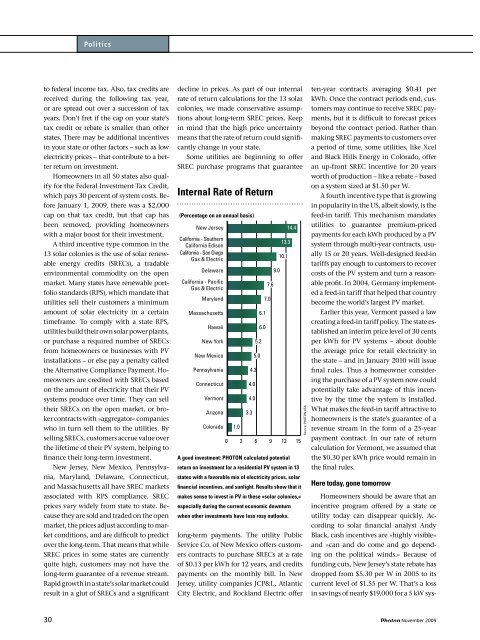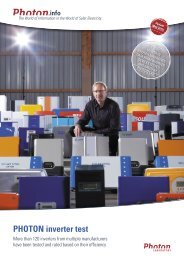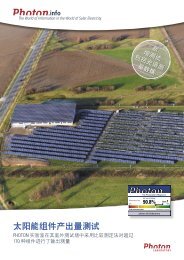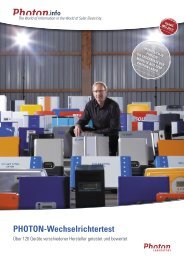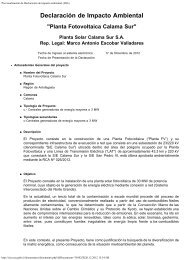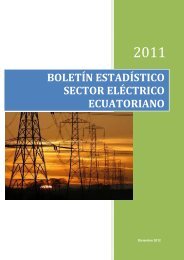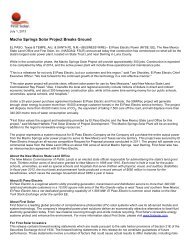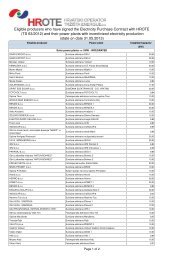INTRODUCTORY SPECIAL INTRODUCTORY ... - PHOTON Info
INTRODUCTORY SPECIAL INTRODUCTORY ... - PHOTON Info
INTRODUCTORY SPECIAL INTRODUCTORY ... - PHOTON Info
You also want an ePaper? Increase the reach of your titles
YUMPU automatically turns print PDFs into web optimized ePapers that Google loves.
Politics<br />
to federal income tax. Also, tax credits are<br />
received during the following tax year,<br />
or are spread out over a succession of tax<br />
years. Don’t fret if the cap on your state’s<br />
tax credit or rebate is smaller than other<br />
states. There may be additional incentives<br />
in your state or other factors – such as low<br />
electricity prices – that contribute to a bet-<br />
ter return on investment.<br />
30<br />
Homeowners in all 50 states also qual-<br />
ify for the Federal Investment Tax Credit,<br />
which pays 30 percent of system costs. Be-<br />
fore January 1, 2009, there was a $2,000<br />
cap on that tax credit, but that cap has<br />
been removed, providing homeowners<br />
with a major boost for their investment.<br />
A third incentive type common in the<br />
13 solar colonies is the use of solar renew-<br />
able energy credits (SRECs), a tradable<br />
environmental commodity on the open<br />
market. Many states have renewable port-<br />
folio standards (RPS), which mandate that<br />
utilities sell their customers a minimum<br />
amount of solar electricity in a certain<br />
timeframe. To comply with a state RPS,<br />
utilities build their own solar power plants,<br />
or purchase a required number of SRECs<br />
from homeowners or businesses with PV<br />
installations – or else pay a penalty called<br />
the Alternative Compliance Payment. Ho-<br />
meowners are credited with SRECs based<br />
on the amount of electricity that their PV<br />
systems produce over time. They can sell<br />
their SRECs on the open market, or bro-<br />
ker contracts with »aggregator« companies<br />
who in turn sell them to the utilities. By<br />
selling SRECs, customers accrue value over<br />
the lifetime of their PV system, helping to<br />
finance their long-term investment.<br />
New Jersey, New Mexico, Pennsylva-<br />
nia, Maryland, Delaware, Connecticut,<br />
and Massachusetts all have SREC markets<br />
associated with RPS compliance. SREC<br />
prices vary widely from state to state. Be-<br />
cause they are sold and traded on the open<br />
market, the prices adjust according to mar-<br />
ket conditions, and are difficult to predict<br />
over the long-term. That means that while<br />
SREC prices in some states are currently<br />
quite high, customers may not have the<br />
long-term guarantee of a revenue stream.<br />
Rapid growth in a state’s solar market could<br />
result in a glut of SRECs and a significant<br />
decline in prices. As part of our internal<br />
rate of return calculations for the 13 solar<br />
colonies, we made conservative assump-<br />
tions about long-term SREC prices. Keep<br />
in mind that the high price uncertainty<br />
means that the rate of return could signifi-<br />
cantly change in your state.<br />
Some utilities are beginning to offer<br />
SREC purchase programs that guarantee<br />
Internal Rate of Return<br />
(Percentage on an annual basis)<br />
New Jersey<br />
California - Southern<br />
California Edison<br />
California - San Diego<br />
Gas & Electric<br />
Delaware<br />
California - Pacific<br />
Gas & Electric<br />
Maryland<br />
Massachusetts<br />
Hawaii<br />
New York<br />
New Mexico<br />
Pennsylvania<br />
Connecticut<br />
Vermont<br />
Arizona<br />
Colorado<br />
1.0<br />
4.3<br />
4.0<br />
4.0<br />
3.3<br />
5.2<br />
5.0<br />
6.1<br />
6.0<br />
7.6<br />
7.0<br />
9.0<br />
13.3<br />
10.1<br />
0 3 6 9 12 15<br />
A good investment: <strong>PHOTON</strong> calculated potential<br />
14.4<br />
return on investment for a residential PV system in 13<br />
states with a favorable mix of electricity prices, solar<br />
financial incentives, and sunlight. Results show that it<br />
makes sense to invest in PV in these »solar colonies,«<br />
especially during the current economic downturn<br />
when other investments have less rosy outlooks.<br />
long-term payments. The utility Public<br />
Service Co. of New Mexico offers custom-<br />
ers contracts to purchase SRECs at a rate<br />
of $0.13 per kWh for 12 years, and credits<br />
payments on the monthly bill. In New<br />
Jersey, utility companies JCP&L, Atlantic<br />
City Electric, and Rockland Electric offer<br />
Source: <strong>PHOTON</strong> USA<br />
ten-year contracts averaging $0.41 per<br />
kWh. Once the contract periods end, cus-<br />
tomers may continue to receive SREC pay-<br />
ments, but it is difficult to forecast prices<br />
beyond the contract period. Rather than<br />
making SREC payments to customers over<br />
a period of time, some utilities, like Xcel<br />
and Black Hills Energy in Colorado, offer<br />
an up-front SREC incentive for 20 years<br />
worth of production – like a rebate – based<br />
on a system sized at $1.50 per W.<br />
A fourth incentive type that is growing<br />
in popularity in the US, albeit slowly, is the<br />
feed-in tariff. This mechanism mandates<br />
utilities to guarantee premium-priced<br />
payments for each kWh produced by a PV<br />
system through multi-year contracts, usu-<br />
ally 15 or 20 years. Well-designed feed-in<br />
tariffs pay enough to customers to recover<br />
costs of the PV system and turn a reason-<br />
able profit. In 2004, Germany implement-<br />
ed a feed-in tariff that helped that country<br />
become the world’s largest PV market.<br />
Earlier this year, Vermont passed a law<br />
creating a feed-in tariff policy. The state es-<br />
tablished an interim price level of 30 cents<br />
per kWh for PV systems – about double<br />
the average price for retail electricity in<br />
the state – and in January 2010 will issue<br />
final rules. Thus a homeowner consider-<br />
ing the purchase of a PV system now could<br />
potentially take advantage of this incen-<br />
tive by the time the system is installed.<br />
What makes the feed-in tariff attractive to<br />
homeowners is the state’s guarantee of a<br />
revenue stream in the form of a 25-year<br />
payment contract. In our rate of return<br />
calculation for Vermont, we assumed that<br />
the $0.30 per kWh price would remain in<br />
the final rules.<br />
Here today, gone tomorrow<br />
Homeowners should be aware that an<br />
incentive program offered by a state or<br />
utility today can disappear quickly. Ac-<br />
cording to solar financial analyst Andy<br />
Black, cash incentives are »highly visible«<br />
and »can and do come and go depend-<br />
ing on the political winds.« Because of<br />
funding cuts, New Jersey’s state rebate has<br />
dropped from $5.30 per W in 2005 to its<br />
current level of $1.55 per W. That’s a loss<br />
in savings of nearly $19,000 for a 5 kW sys-<br />
November 2009


